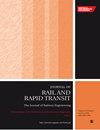利用疲劳裂纹起裂参数对曲线轨道裂纹位置进行三维有限元分析
IF 1.7
4区 工程技术
Q3 ENGINEERING, CIVIL
Proceedings of the Institution of Mechanical Engineers Part F-Journal of Rail and Rapid Transit
Pub Date : 2023-09-28
DOI:10.1177/09544097231203269
引用次数: 0
摘要
轮轨相互作用动力学建模对铁路的精确疲劳分析具有重要意义。接触区域内接触应力的位置和大小必须通过计算工具准确有效地评估。在弯曲轨道上,车轮所受的力是多轴而非单轴的,分布复杂;因此,需要一个更全面的计算模型。本文建立了弯曲轨道疲劳裂纹萌生的数值模拟方法。利用通用机构软件将轴向轮力谱作为输入输入到三维显式有限元模型中,从而得到轮轨接触区域的应力。将von Mises应力值最大的临界单元作为疲劳裂纹最有可能发生的单元。在该单元中,采用临界平面法确定裂纹起裂的方向。建立了半径和滑移比对疲劳裂纹起裂位置的影响,研究了接触点对疲劳裂纹起裂参数的影响。该模型利用弯曲轨道的几何特性,成功地预测了实际轮轨在循环荷载下的动态响应。本文章由计算机程序翻译,如有差异,请以英文原文为准。
Using the fatigue crack initiation parameter for prediction of the crack location on a curved track by 3D-FE analysis
Dynamic modeling of wheel-rail interaction is significant in accurate fatigue analysis of railways. Both location and magnitude of the contact stresses in the contact area must be evaluated accurately and efficiently via computational tools. In curved railway tracks, the distribution of the force exerted on the wheel is complex as it is multiaxial rather than uniaxial; thus, a more comprehensive computational model is required. In this work, a numerical procedure is developed to investigate the fatigue crack initiation on the curved tracks. The Universal Mechanism software is used to specify the spectrum of axial wheel force as input to a three-dimensional explicit finite element model to obtain the resulting stresses at the wheel-rail contact region. A critical element with the maximum von Mises stress value is treated as the element where the fatigue crack is most probably to be initiated. In this element, the critical plane method is used to determine the orientation of the crack initiation. The effect of the radius and slip ratio on the exact site of fatigue crack initiation is established in this approach, and the contact point influence on the fatigue crack initiation parameter is investigated. The proposed model successfully predicts a practical wheel-rail dynamic response to cyclic loading, applying the geometry of the curved track.
求助全文
通过发布文献求助,成功后即可免费获取论文全文。
去求助
来源期刊

CiteScore
4.80
自引率
10.00%
发文量
91
审稿时长
7 months
期刊介绍:
The Journal of Rail and Rapid Transit is devoted to engineering in its widest interpretation applicable to rail and rapid transit. The Journal aims to promote sharing of technical knowledge, ideas and experience between engineers and researchers working in the railway field.
 求助内容:
求助内容: 应助结果提醒方式:
应助结果提醒方式:


